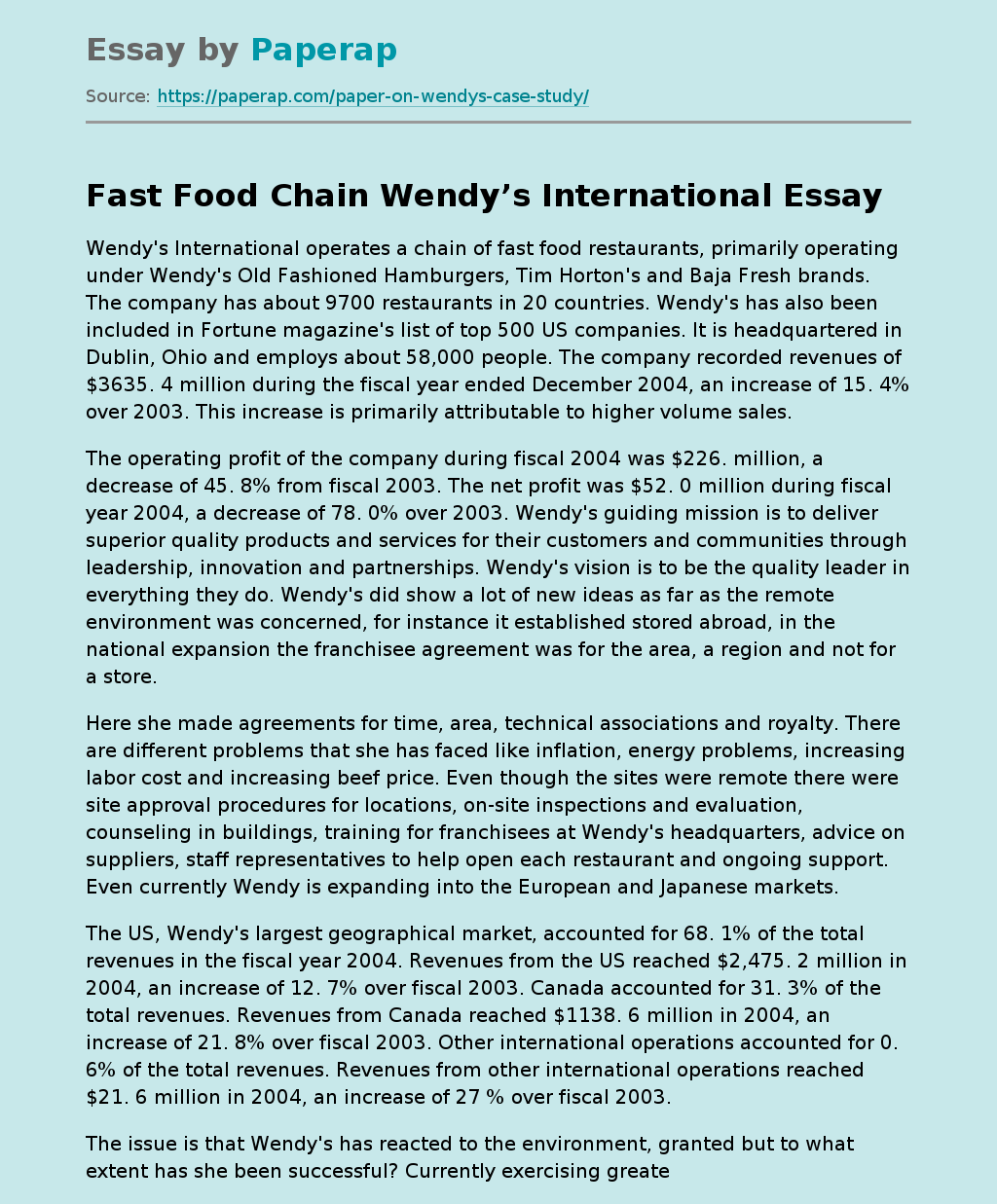Fast Food Chain Wendy’s International
Wendy’s International operates a chain of fast food restaurants, primarily operating under Wendy’s Old Fashioned Hamburgers, Tim Horton’s and Baja Fresh brands. The company has about 9700 restaurants in 20 countries. Wendy’s has also been included in Fortune magazine’s list of top 500 US companies. It is headquartered in Dublin, Ohio and employs about 58,000 people. The company recorded revenues of $3635. 4 million during the fiscal year ended December 2004, an increase of 15. 4% over 2003. This increase is primarily attributable to higher volume sales.
The operating profit of the company during fiscal 2004 was $226. million, a decrease of 45. 8% from fiscal 2003. The net profit was $52. 0 million during fiscal year 2004, a decrease of 78. 0% over 2003. Wendy’s guiding mission is to deliver superior quality products and services for their customers and communities through leadership, innovation and partnerships. Wendy’s vision is to be the quality leader in everything they do. Wendy’s did show a lot of new ideas as far as the remote environment was concerned, for instance it established stored abroad, in the national expansion the franchisee agreement was for the area, a region and not for a store.
Here she made agreements for time, area, technical associations and royalty. There are different problems that she has faced like inflation, energy problems, increasing labor cost and increasing beef price. Even though the sites were remote there were site approval procedures for locations, on-site inspections and evaluation, counseling in buildings, training for franchisees at Wendy’s headquarters, advice on suppliers, staff representatives to help open each restaurant and ongoing support.
Even currently Wendy is expanding into the European and Japanese markets.
The US, Wendy’s largest geographical market, accounted for 68. 1% of the total revenues in the fiscal year 2004. Revenues from the US reached $2,475. 2 million in 2004, an increase of 12. 7% over fiscal 2003. Canada accounted for 31. 3% of the total revenues. Revenues from Canada reached $1138. 6 million in 2004, an increase of 21. 8% over fiscal 2003. Other international operations accounted for 0. 6% of the total revenues. Revenues from other international operations reached $21. 6 million in 2004, an increase of 27 % over fiscal 2003.
The issue is that Wendy’s has reacted to the environment, granted but to what extent has she been successful? Currently exercising greater control over the current franchisees and also exercising greater control over the franchisees and expanding in foreign countries is an example of adapting to remote environment. Within the industry environment, Wendy came up with the idea of having a quarter pound patties, square patties and only burgers so that she could carve a niche for herself.
She did not want to go head long into direct competition with McDonald’s and Burger King’s. Wendy’s showed good adaptability by differentiated her menu from that of her competitors. In 1979, Wendy has started the salad bar and breakfast concept which has been accepted well. Then it began to increase the dinner and weekend business and prepared to open another 240 to 300 Wendy’s restaurants system wide. In short to every challenge and problem she had faced, Wendy’s has been able to come up with an adaptation.
Wendy’s innovation pipeline produced several new products in 2004, including our Chicken Temptations sandwiches, Spinach Chicken Salad and Home-style Chicken Strips Salad. Wendy’s also introduced their new Kids’ Meals, which allow the substitution, at no extra charge, of Mandarin oranges for fries, and milk for a soft drink. Wendy’s saw many of their product and service innovations such as salads, premium sandwiches, chicken strips, healthy menu options and late-night hours being imitated by their competitors in 2004. Wendy also streamlined her building, pickup window and dioor.
This contributed to her delivery system. Wendy’s turned out to be according to their own reporting, the fastest delivery system in the industry. In the 1980-89 Wendy’s brought about a change in the management reorganization which was responsible for major restructuring, a move which shows adaptability in the operating environment. Wendy’s operational focus will continue during 2005 with the rollout of the double-sided grill, which offers competitive advantages in improved product safety, enhanced product quality, faster cooking times and labor savings.
Wendy’s expect the double-sided grill to be implemented system wide by 2007. Along with the double-sided grill rollout, Wendy’s is moving forward with the implementation of new technology in their Wendy’s restaurants. Electronic payment, which is now in nearly all of their stores, is a convenience for their customers and results in a higher average check. As part of their store automation program, Wendy’s have also implemented demand forecasting, labor scheduling and computer based training to improve their store-level efficiencies.
Fast Food Chain Wendy’s International. (2017, Dec 21). Retrieved from https://paperap.com/paper-on-wendys-case-study/

